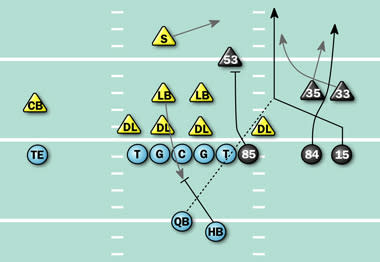Niners need to 'cross' opponents
Also in this article:
Next Surveillance:
Steelers
More NFL:
Editor's note: Yahoo! Sports will examine the biggest weakness of the 2009 season for every team and explain how the franchise can address the issue. The series continues with the 49ers, who finished second last season in the NFC West (8-8).
Biggest problem in 2009: An offense that needed to catch up with its defense

Mike Singletary coached the 49ers to an 8-8 record in 2009.
(Nick Laham/Getty Images)
After a very dry spell in the mid-2000s, the San Francisco 49ers have tried to get over the hump and back on the winning track. In taking over a team that hasn't posted a winning record since 2002, new full-time head coach Mike Singletary had to do two things: Establish a culture of toughness and accountability, and allow his team to benefit from what he knew. As one of the best middle linebackers in NFL history, Singletary worked with defensive coordinator Greg Manusky and a host of talented players to shape one of the NFL's most underrated defenses in 2009. Last year's defense gave up the fourth-fewest points in the league (17.6 ppg, establishing the team's first positive point differential since 2003), and several players stepped up. Linebacker Patrick Willis(notes) and nose tackle Aubrayo Franklin(notes) reinforced their status as franchise cornerstones. End/tackle Justin Smith(notes) had as many quarterback hurries (29) as Dallas pass-rushing expert DeMarcus Ware(notes). Surprise players like safety Dashon Goldson(notes) and linebacker Ahmad Brooks(notes) stepped up and had career years.

Crabtree
While that was all well and good, San Francisco's offense continued a struggle that has now lasted several seasons – the team hasn't ranked in the top 10 in scoring or yards since 2003. Shaun Hill(notes) gave way to Alex Smith at quarterback after the first five games. First-round pick Michael Crabtree(notes), a prodigious receiver from Texas Tech, ended his holdout in time for Smith's first game of the season against the Texans in Week 7. However, Crabtree took a while to get up to speed, and his sense of route concepts wasn't very advanced from his days in Mike Leach's(notes) spread offense at Texas Tech.
Crabtree was targeted just four times in the red zone (out of 86 total targets) and caught no passes; his two touchdowns in his rookie season had to be a severe letdown after scoring 41 touchdowns in just two seasons at Tech. Smith, who benefited from San Francisco's increased use of the shot gun (from 15 percent in 2008 to 45 last season) has not graduated to anyone's idea of a franchise quarterback, but Crabtree caught those college passes from Graham Harrell(notes), who washed out of the NFL entirely.
There definitely were some positives last year, including the breakout season by Vernon Davis(notes), which resulted in an NFL record-tying 13 touchdowns by a tight end. But if the 49ers are to take the next step and climb out of offensive stagnancy, they'll have to look for different ways to put Crabtree in scoring situations.
The 2010 solution: Use Crabtree to cross up defenses

One thing that the 49ers did effectively (though too infrequently) with Crabtree in 2009 was to use him in little inside slants in combo routes, with fellow receiver Josh Morgan(notes) running from the slot or flex to the outside. In a Week 10 win over the Bears, Morgan and Crabtree gave a great example of how this "cross-up" concept can clear space in the middle of a route combination and get defenders following the wrong target. With 13:16 left in the first quarter and the 49ers at their own 41-yard line, Crabtree (15) was wide right with Morgan (84) inside (see illustration). At the snap, Morgan headed slightly to the right, taking cornerback Zack Bowman (35) out of the read and actually running a bit of a pick on cornerback Charles Tillman(notes) (33). At the same time, tight end Vernon Davis (85) did an outstanding job of blocking linebacker Nick Roach(notes) (53) out of the play, which let Crabtree get downfield after the catch. The play went for 15 yards, but 11 of those yards came after the catch, and those yards were based more on a great route combination and Davis' underrated blocking abilities than Crabtree's explosion off the cut.
It's not hard to extrapolate the effectiveness of such strategies in the red zone. The Bears were playing tight man coverage on the strong side and sent their two second-level linebackers (Lance Briggs(notes) and Hunter Hillenmeyer(notes)) with abandon, which put nine defenders at or near the line of scrimmage right after the snap. Hillenmeyer then had to recover and try to stop the play as Crabtree headed upfield. Those quick slants to Crabtree work just as well in the pros as they did in college, and they'll work even better if another receiver clears coverage in a compressed space. The 49ers have a total touchdown machine on their roster; they just need to figure out the best ways to get him open on a consistent basis.
